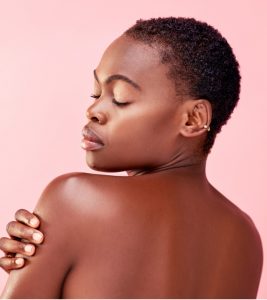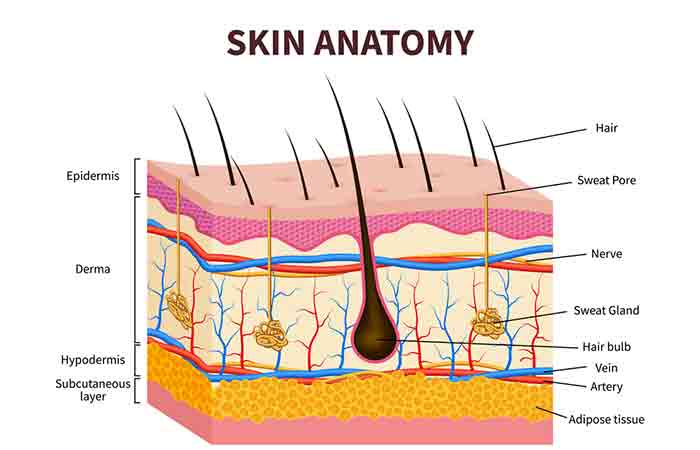Thick skin has a thinner dermis and lacks hair follicles, sebaceous glands, and apocrine sweat glands, while delicate skin contains these features. Thick skin is typically found in high-abrasion areas like the fingertips, palms, and soles of the feet.
It is more flexible and pliable compared to thin skin. In contrast, delicate skin covers most of the body and varies in thickness, with the most delicate skin on the eyelids. The structural and histological differences between thick and thin skin include variations in the dermis and the presence or absence of hair follicles, sebaceous glands, and apocrine sweat glands.
Understanding these differences is essential to comprehend the characteristics and functions of different skin types.

Differences Between Thick Skin And Thin Skin
Thick skin, found on fingertips, palms, and the soles of the feet, has a thinner dermis and lacks hairs, sebaceous glands, and apocrine sweat glands. In contrast, delicate skin covers most of the body, has hair follicles, and contains eccrine and apocrine sweat glands.
Structure And Composition
Thick skin and thin skin differ in terms of their structure and composition. As the name suggests, thick skin is more comprehensive than light skin. The dermis of thick skin is more delicate compared to delicate skin. Moreover, thick skin lacks hair follicles, sebaceous glands, or apocrine sweat glands. On the other hand, soft skin contains hair follicles and both eccrine and apocrine sweat glands.
Presence Of Hair, Glands, And Sweat
In terms of hair, thick skin is hairless, while thin skin contains hair follicles. Additionally, thick skin does not have sebaceous glands or apocrine sweat glands. These glands are only present in light skin, along with eccrine sweat glands. The presence or absence of hair, glands, and sweat glands significantly differs between thick and delicate skin.
Location On The Body
The location on the body also distinguishes between thick and thin skin. Thick skin is found in areas that experience a lot of abrasion, such as the fingertips, palms, and soles of the feet. These areas require extra protection and a more substantial barrier against external factors. On the other hand, thin skin covers most of the body and can vary in thinness. The thinnest skin can be found on the eyelids, providing a delicate covering for this sensitive area.

Impact And Characteristics
Thick skin and thin skin have distinct differences. Thick skin, found in areas prone to abrasion like fingertips and palms, lacks hair, sebaceous glands, and apocrine sweat glands. On the other hand, thin skin covering most of the body contains hair follicles and sweat glands.
Physical Resilience And Sensitivity
Thick and thin skin have distinct characteristics that affect their physical resilience and sensitivity. Thick skin, found in areas prone to abrasion like the fingertips, palms, and soles of the feet, is less sensitive and more durable than thin skin. Its thicker dermis provides a protective barrier, making it less likely to get injured by minor cuts, pinches, or external irritants. On the other hand, the thin skin covering most of the body, including the eyelids, is more sensitive to touch and temperature changes due to its more delicate structure.
Flexibility And Pliability
The flexibility and pliability of the skin also vary between thick and thin skin. Thin skin is more pliable and flexible, allowing for greater freedom of movement. It has a thinner stratum corneum, the outermost layer of the epidermis, which contributes to its increased flexibility. Thick skin, however, provides a sturdier structure with a thicker dermis, making it less flexible but more resistant to friction and wear.
Appearance And Thickness
When it comes to appearance and thickness, there are noticeable differences between thin and thick skin. Thick skin is hairless and lacks sebaceous glands and apocrine sweat glands, while delicate skin contains hair follicles and eccrine and apocrine sweat glands. The skin on the palms and soles is characterized by its thickness, while the skin under the eyes is the thinnest. This variation in thickness contributes to each type of skin’s different functions and protective abilities.
Histological Variations
When understanding the differences between thin and thick skin, it is essential to explore their histological variations. The histology of the skin reveals distinct characteristics that set these two types apart. Let’s delve into the histological variations in thin and thick skin by examining the dermal differences, collagen fiber composition, and the presence of the stratum lucidum.
Dermal Differences
The dermis is crucial in providing structural support and nourishment to the skin. In thin skin, the dermis is relatively more delicate compared to thick skin. This variation can be attributed to the locations where each skin type is found. Soft skin covers most of the body, while thick skin is only present in areas that experience more abrasion, such as the fingertips, palms, and soles of the feet.
Collagen Fiber Composition
Collagen is a vital component of the skin, providing strength and elasticity. However, thin and thick skin exhibit differences in their collagen fiber composition. Thick skin contains a higher concentration of collagen fibers, contributing to its greater resilience and durability. On the other hand, thin skin has a lower density of collagen fibers, making it more pliable and flexible.
Presence Of Stratum Lucidum
One distinctive feature of thick skin is a unique layer called the stratum lucidum. This translucent layer is located between the stratum granulosum and the stratum corneum. Its role is to provide additional protection and a moisture barrier, further reinforcing the resilience of thick skin. In contrast, thin skin lacks this extra layer, making it less protected against external stressors.
In conclusion, examining the histological variations between thin and thick skin reveals significant differences in dermal composition, collagen fiber density, and the stratum lucidum. These variations contribute to these two skin types’ contrasting characteristics and functionalities. Understanding these differences is vital for proper skin care and addressing specific needs based on skin type.

Frequently Asked Questions Of Thin And Thick Skin: Know The Differences Here
What Is The Difference In Thick Skin And Thin Skin?
Thick skin is found in areas like the fingertips and soles of the feet, has a thinner dermis, and lacks hair follicles, sebaceous glands, and apocrine sweat glands. Delicate skin covers most of the body, has a variable thickness, and contains hair follicles and sweat glands.
Thick-skinned individuals are less affected by physical and emotional harms compared to those with thin skin.
What Is The Difference Between Thick Skin And Thin Skin Quizlet?
Thick skin is found in areas with high abrasion, like fingertips and soles, and lacks hair, sebaceous glands, and sweat glands. Thin skin covers most of the body and has hair follicles and eccrine and apocrine sweat glands. Thick skin is less flexible due to a thinner dermis.
Thick skin is physically resilient, while thin skin is more easily affected by physical harm and criticism.
What Does It Mean To Be Thick-Skinned Or Thin-Skinned?
Thick-skinned individuals are not easily affected by criticism, rejection, or physical harm, while thin-skinned people are more sensitive and easily hurt.
Is Thick Skin Generally More Flexible Than Thin Skin?
Thick skin is generally more flexible than thin skin because it has a thinner stratum corneum, making it more pliable and supple.
Conclusion
To sum up,
It contains hair follicles and eccrine and apocrine sweat glands. Understanding these distinctions can help us better appreciate the structures and functions of our skin.
DIY hair oils are some of the most important ingredients to have in your beauty arsenal. They add shine, manage frizzy hair, and help improve your hair health.